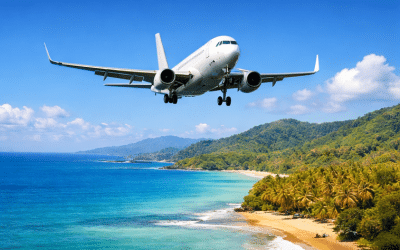Costa Rica’s Migratory Bird Season Takes Flight
What makes Costa Rica’s wetlands a hotspot for migratory birds?
Costa Rica’s wetlands serve as critical rest stops and breeding grounds for migratory birds, offering an abundance of food, mild weather, and diverse habitats. From August to November, these marshy zones come alive with movement as birds arrive in waves, feeding, nesting, and preparing for the next leg of their journey.
Top hotspots include:
Palo Verde National Park – Located in Guanacaste, this park features seasonal floodplains that become a magnet for waterbirds. It’s one of the best places in Central America to witness large flocks of storks and spoonbills.
Caño Negro Wildlife Refuge – Tucked away in the north near the Nicaraguan border, this remote refuge is a haven for migratory birds that thrive in swampy lowlands. It’s best explored by boat, especially during the wet season.
Tempisque River Basin – This region blends agricultural lands with natural wetlands, drawing birds to flooded pastures and oxbow lakes where food is abundant.
Tárcoles River Estuary – Near the central Pacific coast, this area is ideal for spotting great egrets and northern jacanas, particularly at sunrise when bird activity peaks.
Which migratory birds are arriving in Costa Rica right now?
Some of the most elegant and visually striking migratory birds are touching down in Costa Rica’s wetlands. From pink flashes in the reeds to ghost-white silhouettes on the water, these species are hard to miss and a dream for birdwatchers.
Roseate Spoonbill – With flamboyant pink feathers and a bill shaped like a spatula, this bird looks like a flamingo designed by Salvador Dalí. They sweep their beaks side-to-side in shallow waters to catch shrimp and small fish.
Wood Stork – These tall, bald-headed waders are surprisingly graceful in the air. They form large colonies in trees and are often seen gliding silently over wetlands.
Northern Jacana – Known for their exceptionally long toes, these birds can seemingly walk on water by striding across lily pads. Their metallic green wings and yellow facial shields make them especially photogenic.
Great Egret – Statuesque and elegant, the great egret is easy to spot with its all-white plumage and long, S-curved neck. Watch as they stalk prey in slow, deliberate steps before striking with lightning speed.

When is the best time to witness this bird frenzy?
The prime window for birdwatching runs from September through October, when migratory activity is at its peak and courtship displays fill the wetlands with movement and sound.
Dawn and dusk – These are the golden hours for observation. Birds are most active at sunrise and sunset, feeding, flying, and socialising.
After seasonal rains, freshly flooded areas bring out fish, frogs, and insects, which attract hungry birds looking to refuel during their journey.
Periods of low human activity – Visiting during quieter hours of the day ensures the birds are less disturbed and more likely to stay visible.
Where can you go birdwatching during migration season?
Birdwatching in Costa Rica is best experienced in the northern lowlands and coastal zones, where wetlands provide the perfect mix of food, shelter, and water. Travel by foot, boat, or even horseback to explore these living bird theatres.
Palo Verde National Park – Its blend of dry tropical forest and seasonal swamps attracts more than 300 species of birds. Look for massive flocks feeding and nesting in the flooded pastures.
Caño Negro Wildlife Refuge – Known as a mini–Amazon, this wetland paradise can only be accessed by water. Glide silently past herons, kingfishers, and jacanas while surrounded by dense foliage and silence.
Tárcoles River Estuary – Not far from the Pacific coast and home to both birds and crocodiles, this is a must-visit site for photographers. Riverboat tours bring you face-to-face with great egrets and spoonbills in action.
Cabo Blanco and Nicoya Estuaries – These lesser-known areas offer solitude and spectacular birding. The diversity here includes migratory and resident birds in tidal mangroves and forested river mouths.
Why is this migration so important to the environment?
Migratory birds are not just beautiful—they are vital to the health of ecosystems in Costa Rica and beyond. They link continents through their seasonal journeys and provide essential services.
Natural pest control – Birds such as spoonbills and jacanas feed on insects and larvae, helping control mosquito populations and protecting crops.
Nutrient cycling – Bird droppings fertilise soil and aquatic systems, enriching the habitat for plants and other wildlife.
Support for ecotourism – Birdwatching tourism generates income for local communities and funds for conservation projects, creating incentives to protect these precious environments.
What can you do to help protect Costa Rica’s wetlands?
Even if you’re just visiting, small efforts make a big difference. Protecting bird habitats during migration season ensures these species return year after year.
Support eco-certified guides – Trained local guides know how to spot birds without disturbing them. Hiring one boosts the local economy and keeps conservation at the forefront.
Follow Leave No Trace principles – Stay on marked trails, don’t leave rubbish behind, and resist the urge to chase or flush out birds.
Say no to single-use plastics – Much of the waste that ends up in rivers and wetlands affects bird health and pollutes feeding grounds.
Contribute to conservation efforts – Organisations like MINAE and local nonprofits often run reforestation and wetland rehabilitation programmes that rely on community donations and volunteers.
FAQ
Q: Can beginners enjoy birdwatching during migration season?
Absolutely. Many of the birds are large, colourful, and active during daylight, making them easy to spot even for newcomers.
Q: Is birdwatching only possible in national parks?
No. While national parks offer great infrastructure, many private reserves and even rural communities near wetlands offer excellent birding opportunities.
Q: Are guided birdwatching tours worth it?
Yes. Guides enhance the experience with expert knowledge, spotting scopes, and access to less-known birding spots.
Q: Can I photograph birds without disturbing them?
Yes, but use a zoom lens, avoid flash, and stay quiet. Patience rewards you with the most authentic shots.
Q: How is climate change affecting bird migration in Costa Rica?
Irregular rainfall and shifting temperatures are impacting food availability and the timing of migration, which could reduce bird populations in the future.






